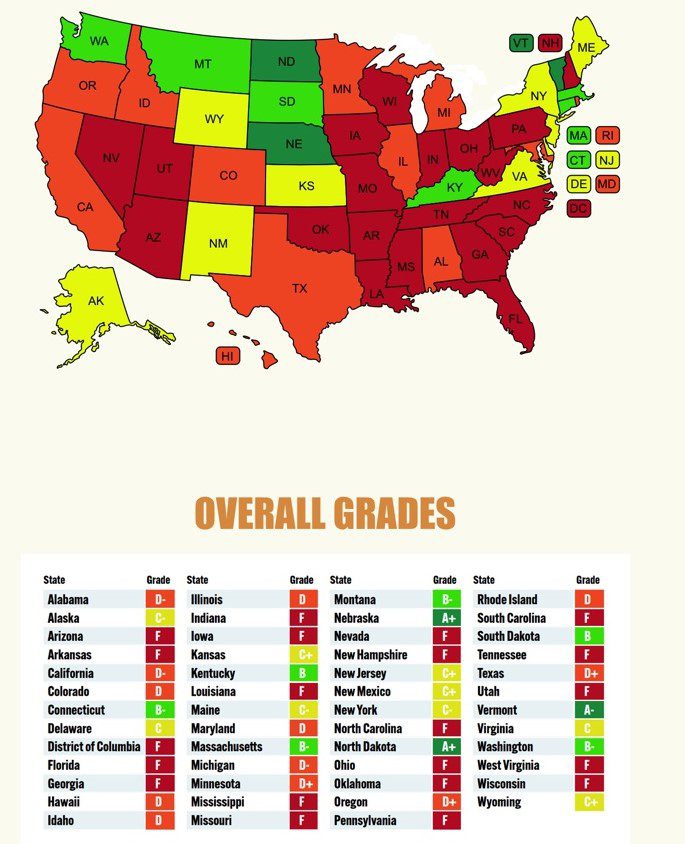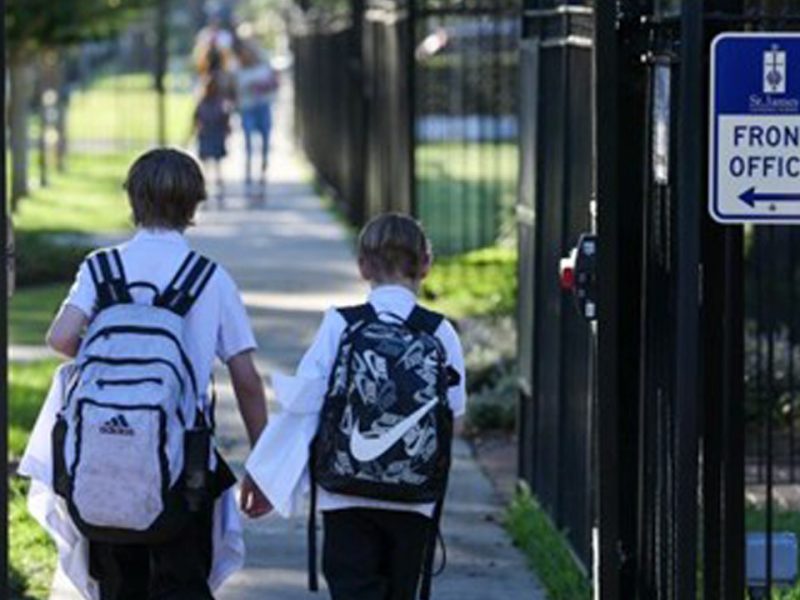Privatization of public education gaining ground, report says
The Washington Post | By Valerie Straus | April 18, 2022
The movement to privatize public education is gaining ground in the United States at a time when traditional public school districts are facing some of the most severe challenges ever.
According to a report by an advocacy group that supports traditionally funded and democratically governed public school districts, a number of Republican-led legislatures pushed through legislation to expand charter schools and voucher programs during the coronavirus pandemic. Most often these were passed without serious safeguards to ensure that students, families and taxpayers are protected from “discrimination, corruption and fraud” that has marred a number of these programs.
The report, by the Network for Public Education, is a follow-up to a 2018 report by the network and the Schott Foundation for Public Education, which gave five states an “A+” or “A” in regard to their commitment to supporting public schools. In the new report, two states — Nebraska and North Dakota — received an overall grade of “A+” while one state, Vermont, got an “A-”.
There was a decrease in the number of states earning an overall grade of “B” or “C” — 15, seven fewer than in 2018, the report says. The number of states receiving a “D” doubled from six to 12, and the number of states with “F” grades increased from 17 to 20, with the District of Columbia making 21 systems, according to the report. The states with “F” grades are Arizona, Arkansas, Florida, Georgia, Indiana, Iowa, Louisiana, Mississippi, Missouri, Nevada, New Hampshire, North Carolina, Ohio, Oklahoma, Pennsylvania, South Carolina, Tennessee, Utah, West Virginia and Wisconsin.
“School choice” is, supporters say, a movement to expand alternatives to traditional public schools for children who have poor educational options in their neighborhoods and to give parents a choice in their children’s education. Critics say that using public funds to support “choice” schools is undermining the traditional public system, which educates the majority of America’s school-age children, and that privatization gives nonpublic schools the right to discriminate and operate without public scrutiny.
While the choice movement is not monolithic, its most prominent advocates are pushing for public funds to be used for private and religious education. Choice advocates such as former education secretary Betsy DeVos and Florida Gov. Ron DeSantis (R) have called for a new definition of public education — one that says that any school getting public dollars should be considered a public school, even if the public has no say in how it operates.
Those who support choice may be buoyed by the report’s findings that privatization is growing, while critics may be alarmed. “The privatization of public education is now in its adolescence,” the report says. “It has achieved the full-throated support of the right-wing, which now controls many state legislatures. Conserving public schools and local control is no longer part of a conservative platform: destroying locally controlled public schools via privatized choice is.”
The new report looks at the expansion of privatization, educational quality, student rights and protections, accountability and transparency, and safeguards for taxpayer dollars. Choice initiatives include voucher and voucherlike programs and charter schools.
Charter schools are publicly funded but privately operated, many by for-profit companies. Voucher and similar programs use public money to pay for private and religious school tuition or provide tax credits to people who contributed money for that purpose.
The Biden administration recently proposed regulations on the federal Charter School Program to try to meet a campaign promise the president made that he would eliminate federal funding for for-profit charter schools, which have been at the center of major financial scandals.
Charter supporters have attacked the proposed changes, saying that they are aimed at eventually eliminating federal support for charter schools. Biden showed no sign of doing that in his budget proposal, which maintained the charter-program level at $440 million.
This map shows the report’s overall grades, given from the perspective of the Network for Public Education, which opposes the choice movement.

You can see here how points were awarded for the network’s findings, which include:
- Seven states publicly fund home schooling with few if any checks on the quality of instruction or monitoring of student progress.
- Nineteen states do not require teachers in voucher schools to be certified.
- Twenty-six states do not require that voucher students take the same state tests as their public and charter school counterparts.
- Even though some legislatures have enacted voucher programs designed for special education students, only two states and the District of Columbia ensure that all voucher students with disabilities retain their full rights under the Individuals With Disabilities Education Act (IDEA) when they move from a public school to a private one. IDEA is a federal law that bans discrimination against people with disabilities. The other 94 percent of states with voucher programs are either silent regarding student rights or require families to sign away their rights under IDEA to get a voucher.
- Eighty-one percent of states allow voucher schools to discriminate in entrance requirements based on religion. Under the guise of religious freedom, 74 percent allow discrimination based on student and/or parent LGBTQ status.
- Near half (15) of all states with one or more voucher programs do not require background checks for the teachers of voucher-funded students.
- Seven states do not require voucher schools to follow state health and safety regulations that apply to public schools.
- More than half of states with vouchers have at least one program that pays out more than 50 percent of what would have been spent to educate the child in a public school. This is especially concerning since most programs now give tax dollars to students who have never enrolled in a public school. For example, New Hampshire had $8 million drained from its coffers after the first year of its Education Savings Account (ESA) program, as the majority of families already enrolling their child or children at a private school signed up for the program, resulting in much higher costs than predicted.
- ESA programs are especially ripe for fraud. An audit of the Arizona program showed that parents spent over $700,000 in unallowable purchases.
- Although charters claim to be open to everyone via a lottery, 40 states give enrollment preferences to students beyond disadvantaged students. Four states allow charter schools to shape enrollment using academic and talent screening.
- In 31 states, charter school students do not have the same rights and protections as public school students in disciplinary and expulsion proceedings.
- Thirty-three states either do not require that charter school students be taught by certified and licensed teachers or allow so many exceptions that any existing regulations are meaningless.
- Thirty-seven states allow entirely virtual, online schools; 32 of those enable for-profit corporations to run them. This is despite the preponderance of the evidence that shows students in such schools make poor academic progress and have extremely low (under 50 percent) graduation rates. A recent report by the Government Accountability Office (GAO) entitled “The Department of Education Should Help States Address Student Testing Issues and Financial Risks Associated with Virtual Schools, Particularly Virtual Charter Schools,” found that 56 percent of virtual schools are run by charter management organizations of which 75 percent are for-profit. According to that GAO report, for-profit operations increase financial risk because the profit interest of the management corporation may supersede the school’s provision of high-quality education to its students. The report also noted that online schools, regardless of profit status, educate substantially fewer students who are supposed to be protected from discrimination under IDEA.
- Thirty-seven states and D.C. allow for-profit corporations to run nonprofit charter schools, including via “sweeps” contracts that allow tax dollars and control to be funneled to the for-profit that runs the day-to-day operation of the school. In five states (Arizona, Florida, Michigan, Nevada and Ohio), for-profits run over 30 percent of the charter schools in the state.
- Forty-one states allow schools to contract with businesses owned by charter school board members, and in 19 states, those related party transactions are not required to be disclosed.
- Only one state, Ohio, makes the contracts between charter schools and their management companies accessible on the state department of education website. The lack of transparency also extends to the management corporations that in some cases run virtually every aspect of the school. Forty-one states have no requirement that for-profit or nonprofit management corporations open their books — even to the administrators and board of the charter school it is running, and 37 states do not require that the charter management organization annually report to the charter school, or to the state, how it spends public funding.
- Fraud and mismanagement are one of the common reasons that charter schools shut down. Whether cooking the books on attendance or outright theft, fraudulent practices result in schools being shuttered, sometimes with little warning.






